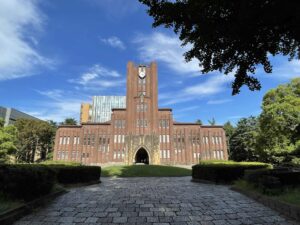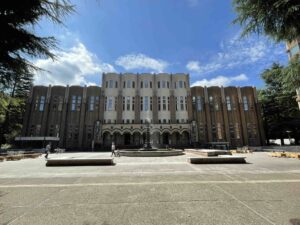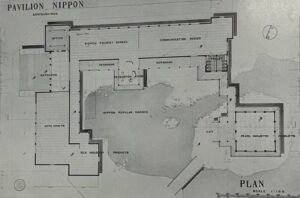This time is also a continuation of the Uchida Yoshikazu series.
In 1939 and 1940, World’s Fairs were held both in San Francisco and New York.
1939/40 San Francisco World’s Fair
The official name of this San Francisco World’s Fair was “Golden Gate International Exposition”.
This World’s Fair was held over two terms: February 18, 1939 to October 29, 1939, and May 25, 1940 to September 29, 1940.
This World’s Fair was held at “Treasure Island” to commemorate the opening of the Golden Gate Bridge and the Bay Bridge, which still attract tourists today.
(The Golden Gate Bridge opened on May 27, 1937. The Bay Bridge (San Francisco-Oakland Bay Bridge) opened on November 12, 1936.)

ゴールデン・ゲート・ブリッジ
Golden Gate Bridge
©️Nobuaki Kyushima
As I reported in detail about this Expo in <38> News of the start of automatic shuttle bus service in San Francisco, it was an Expo that featured various topics such as San Francisco’s version of “the Tower of the Sun” and Westinghouse’s robots.
In <38>, I also wrote:
*
In 1939 and 1940, war was creeping up on both Japan and the United States.
Nevertheless, Japan was second only to the US Federal Building in size and cost.
Looking at the materials, it looks like a combination of a Japanese castle and a Japanese house. There is also an excursion-style (kaiyu-style) Japanese garden.

日本館の描かれたポストカード
A postcard featuring the Japan Pavilion
After the Fair, Japan made an offer to hand over the building to someone free of charge, but since the building was brought in without customs duty, there was no taker who could pay the customs duty, and in the end, it was incinerated and lost in May 1941.
*
1939/40 New York World’s Fair
The World’s Fair was also held in New York in 1939 and 1940.
Official name: New York World’s Fair 1939-1940
The World’s Fair was held over two terms, April 30th to October 31st, 1939, and May 11th to October 27th, 1940.
The theme was “The World of Tomorrow” in 1939 and “For Peace and Freedom” in 1940.
One of the reasons for holding this World’s Fair was to commemorate the 150th anniversary of George Washington’s inauguration as the first president of the United States.
The venue is what is now called Flushing Meadows Corona Park. The location is close to the current La Guardia Airport, and was originally a swampy area known as the Corona Dump.
The venue was vast, with an area of approximately 500 hectares, and its symbols include the 210-meter-tall triangular pyramid “Trylon” and the gigantic sphere “Perisphere” about 60 meters in diameter. At the time, the site was the second-largest World’s Fair in history, only after the 1904 St. Louis World’s Fair (508 hectares). One of the objectives of the Expo was to redevelop this area as a park, and if profits were made from the Expo, $2 million would be prioritized to be used to fund the development of the park.

ペリスフィア(左)とトライロン
Perisphere (left) and Trilon
The venue’s symbols, “Trylon” and “Perisphere,” were created by Henry Dreyfuss (1904-1972), a popular industrial designer at the time who created Hoover’s streamlined vacuum cleaner and the New York Central Railroad’s bullet-shaped train, “Twentieth Century.”
Inside the Perisphere, there was a panoramic themed exhibition with the coined word “Democracity,” an image of a future metropolis with a working population of 250,000 and a population of 1 million.
It was also at this World’s Fair that the now-defunct “League of Nations” became the first international organization to participate in a World’s Fair.
Also, at this World’s Fair, as at the San Francisco World’s Fair, Westinghouse exhibited the humanoid robot “Elektro” and the dog-like robot “Sparko.”
In addition, in New York, it has left behind topics such as a project to bury a “time capsule” 15 meters underground at the World’s Fair site, which should not be opened until 5,000 years from now.

エレクトロとスパーコ
Elektro and Sparko

ウェスティングハウスのタイムカプセル(1938年)
Time Capsule of Westinghouse (1938)
From Japan, Mikimoto exhibited “Liberty Bell.” This is a pearl imitation of the Liberty Bell that was rung on July 4, 1776, when the Declaration of Independence was adopted in the United States, and contains 12,250 pearls and 366 diamonds. It is one-third the size of the actual bell preserved at Independence Hall in Philadelphia, and just like the real bell, even the cracks are created with blue pearls. This pearl-made Liberty Bell is said to have astounded all of America as the “million-dollar bell.”
Uchida Yoshikazu, who designed the Japan Pavilions at both World Fairs.
It was Yoshikazu Uchida (1885-1972) who designed the Japan Pavilions at both World Expos.
Recently, on this blog, I have introduced famous buildings such as Yasuda Auditorium, University of Tokyo General Library, Nishoku, and Shichitokudo on the University of Tokyo Hongo Campus, as well as the former Ichiko Main Building (currently “Building 1”), Auditorium (“Classroom No. 900”)and “Former Ichiko Dormitory- Churyo Hokuryo, Nanryo, Meiryo” (“Komaba Dormitory” or “Komaryo”).
Yoshikazu Uchida was the designer of all the buildings mentioned above and he became the president of the University of Tokyo later.

安田講堂(「東大大講堂」)
Yasuda Auditorium (“Tokyo University Auditorium”)

東京大学総合図書館
General Library, The University of Tokyo
According to the “Collection of Works by Uchida Yoshikazu” (hereinafter referred to as “Collection of Works”), it says as follows.
*
Japan built a Japanese pavilion in the style of a shrine in New York and of a Buddhist temple in San Francisco.
The former was based on the idea of Dr. Kishida Hideto, and the latter was based on the idea of Dr. Matsushita Kiyoo, with Professor Uchida taking overall direction. According to the professor, he had “people close to him” in the University of Tokyo’s architecture department submit a proposal, which was reviewed by Professors Ito Chuta and Okuma Yoshikuni, and Professor Uchida.
For implementation, a contract was signed with New York architect Mr. Matsui as the core architect. Mr. Toki Tatsuto was dispatched to represent Professor Uchida, and Mr. Shimizu Hajime, a one-year junior at university, accompanied him from the construction company Okura Gumi (now Taisei Corporation). At the time, some people criticized the project for its unchanging Japanese style of shrines and temples, but Professor Uchida, who oversaw the whole project, was made an honorary citizen of New York and received a silver medal for his efforts.
(Bold letters are by the author)
*
Speaking of Kishida Hideto, he was the man who, in the Yasuda Auditorium designed by Uchida, had “wire wrapped around it like a spider’s web in a very clever design” (according to “Collection of Works”). He also worked as Uchida’s assistant at the University of Tokyo General Library. He is also the person who designed the nine-ringed fountain that still stands in front of the University of Tokyo General Library.
Looking at the “Collection of Works”, it is true that New York has a shrine-like style, and San Francisco has a Buddhist temple-like style, and it seems that the traditional image of Japan is on full display.

1939/40年サンフランシスコ万博日本館(『内田祥三先生作品集』より)
Japan Pavilion, 1939/40 Golden Gate International Exposition (from “Uchida Yoshikazu Collected Works”)

1939/40年サンフランシスコ万博日本館図面(『内田祥三先生作品集』より)
Floor Plan, Japan Pavilion, 1939/40 Golden Gate International Exposition (from “Uchida Yoshikazu Collected Works”)

1939/40年 ニューヨーク万博日本館(『内田祥三先生作品集』より)
Japan Pavilion, 1939/40 New York World’s Fair (from “Uchida Yoshikazu Collected Works”)

1939/40年 ニューヨーク万博日本館図面(『内田祥三先生作品集』より)
Floor Plan, Japan Pavilion, 1939/40 New York World’s Fair (from “Uchida Yoshikazu Collected Works”)
Considering that Sakakura Junzo’s design for the Japan Pavilion at the 1937 Paris World Exposition two years earlier was a radically modern design made of steel and glass, it is understandable that these two works gave some people an impression of a step back in time.
However, as mentioned above, Uchida Yoshikazu was made an honorary citizen of New York and was awarded a silver medal for his work at the New York World’s Fair.

1939/40年 ニューヨーク万博銀メダル(『内田祥三先生作品集』より)
Silver Medal, 1939/40 New York World’s Fair (from “Uchida Yoshikazu Collected Works”)

ニューヨーク名誉市民・銀賞の賞状(『内田祥三先生作品集』より)
New York Honorary Citizen & Silver Award Certificate (from “Uchida Yoshikazu Collected Works”)
Although the World Expo was held on the eve of World War II, the fact that the award was given to the Japanese pavilion’s very Japanese design could mean that at this point, the American side was still expecting Japan to make various moves towards peace.



